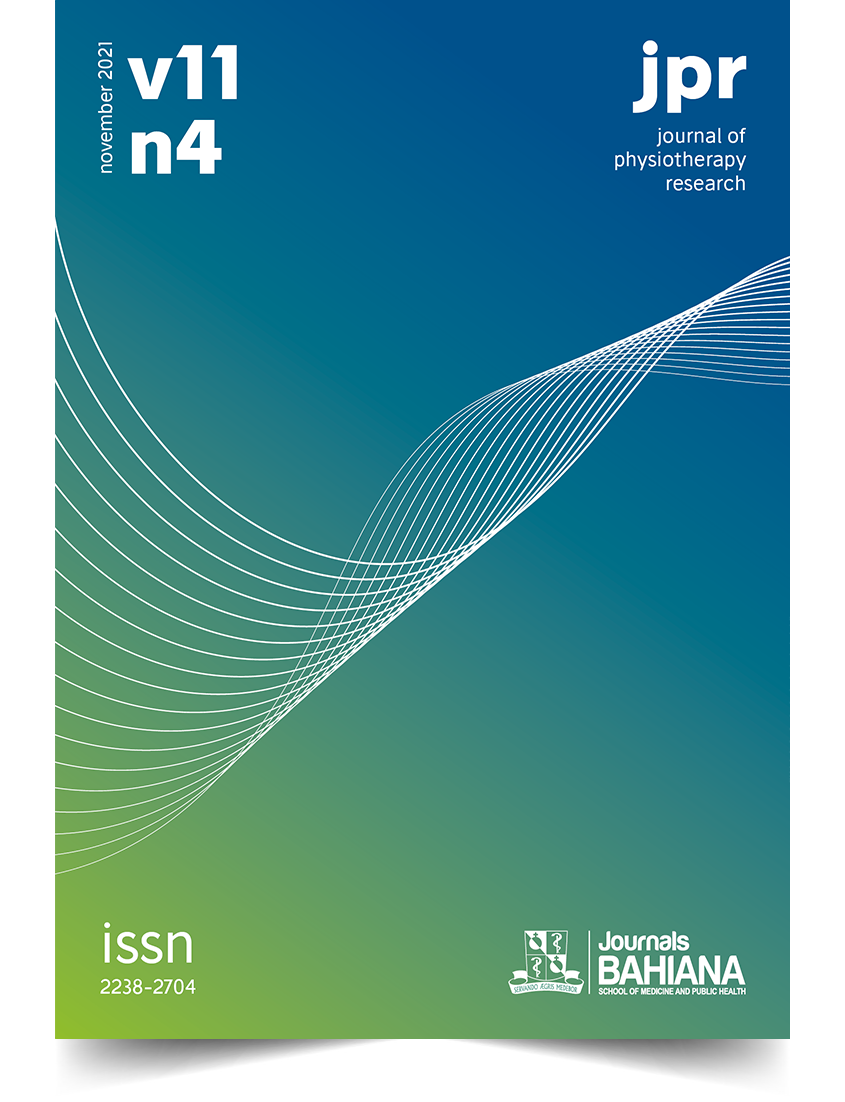Autonomy in ventilatory procedures by physiotherapists working in the intensive care in the state of Bahia: a cross-sectional study
DOI:
https://doi.org/10.17267/2238-2704rpf.v11i4.4167Keywords:
Professional Autonomy, Physiotherapy, Intensive care unit, Physiotherapy Hospital Service, Invasive Ventilatory Support, Noinvasive VentilationAbstract
INTRODUCTION: The Intensive Care Unit (ICU) is a ward intended to the specialized support to critically ill patients or after undergoing a highly complex procedure, who need constant monitoring and care. In this environment, the physiotherapist works to maintain vital functions and helps reduce clinical complications and mortality rates. Furthermore, within their domains, the physiotherapist shares the responsibility for managing methods that replace spontaneous breaths. OBJECTIVE: To describe the autonomy in ventilatory procedures by physiotherapists working in ICUs in the state of Bahia. METHODOLOGY: This is a cross-sectional study with physiotherapists working in ICUs in the state of Bahia, registered at the Regional Council of Physiotherapy and Occupational Therapy of the 7th Region (CREFITO-7). In data, collect was used an electronic questionnaire was developed by the researchers. The data collected was analyzed through descriptive and multivariate statistics. A p-value < 0.05 was set as statistically significant. Statistical analysis was performed with Statistical Package for the Social Sciences, 21.0 version (SPSS Inc., Chicago, IL, EUA). RESULTS: Were evaluated a total of two hundred and sixty-five (265) physiotherapists who work at an Intensive Care Unit in the state of Bahia, with a mean age of 32.4 ±5.4 years, being 61.9% female. Regarding professional autonomy, 94.3% declared that decision-making about physical therapy procedures in the ICU where they work is the responsibility of the physiotherapists. The highest level of autonomy over ventilatory procedures was observed for the application of noninvasive ventilation (97.7%), followed by weaning from mechanical ventilation (97.4%), indication (97%), and maintenance (96.2%). CONCLUSION: Through this study, it was possible to conclude that physiotherapists working in ICUs in the State of Bahia claim to have professional autonomy in relation to ventilatory procedures, especially for the noninvasive ones.
Downloads
References
Nates JL, Nunnally M, Kleinpell R, Blosser S, Goldner J, Birriel B, et al. ICU Admission, Discharge, and Triage Guidelines: A Framework to Enhance Clinical Operations, Development of Institutional Policies, and Further Research. Crit Care Med. 2016;4(8):1553-602. https://doi.org/10.1097/CCM.0000000000001856
Ministério da Saúde (Brazil). Agência Nacional de Vigilância Sanitária. Dispõe sobre os requisitos mínimos para funcionamento de Unidades de Terapia Intensiva e dá outras providências [Internet]. Brasília: Ministério da Saúde; 2010. Available from: http://bvsms.saude.gov.br/bvs/saudelegis/anvisa/2010/res0007_24_02_2010.html
Resolução nº 402 de 03 de agosto de 2011 (Brazil). Disciplina a Especialidade Profissional Fisioterapia em Terapia Intensiva e dá outras providências [Internet]. Brasília: Conselho Federal de Fisioterapia e Terapia Ocupacional; 2011. Available from: http://www.crefito3.org.br/dsn/pdfetica/Res%20Coffito%20402%20-%2003-08-2011-%20Intensiva.pdf
Magalhães FLS. Os benefícios da Ventilação Não Invasiva nos pacientes internados na UTI e em ambulatórios [undergraduate thesis] [Internet]. São Francisco do Conde: Universidade da Integração Internacional da da Lusofonia Afro-Brasileira; 2018. Available from: http://www.repositorio.unilab.edu.br:8080/xmlui/handle/123456789/724
Nozawa E, Sarmento GJV, Vega JM, Costa D, Silva JE, Feltrim MIZ. A profile of Brazilian physical therapists in intensive care units. Fisioter Pesq. 2008;15(2):177-78. https://doi.org/10.1590/S1809-29502008000200011
Reis NF, Gazola NLG, Bundchen DC, Bonorino KC. Ventilação não invasiva na unidade de terapia intensiva de um hospital universitário: características relacionadas ao sucesso e insucesso. Fisioter Pesq. 2019;26(1):3-8. https://doi.org/10.1590/1809-2950/17000626012019
Bonfada MS, Moura LN, Soares SGA, Pinno C, Campogonara S. Autonomy of nurses in the hospital environment. Enfermagem Brasil. 2018;17(5):527-34. https://doi.org/10.33233/eb.v17i5.1503
Melo CMM, Florentino TC, Mascarenhas NB, Macedo KS, Silva MC, Mascarenhas SN. Professional autonomy of the nurse: some reflections. Esc Anna Nery. 2016;20(4):e20160085. https://doi.org/10.5935/1414-8145.20160085
Hodgson CL, Tipping CJ. Physiotherapy management of intensive care unit-acquired weakness. J Physiother. 2017;63(1):4–10. https://doi.org/10.1016/j.jphys.2016.10.011
Barros FBM. Autonomia Profissional do Fisioterapeuta ao longo da história. Fisiobrasil [Internet]. 2003;29:20-31. Available from: https://www.researchgate.net/publication/321186076_AUTONOMIA_PROFISSIONAL_DO_FISIOTERAPEUTA_AO_LONGO_DA_HISTORIA
Câmara AMSC, Santos LLCP. A study on alumni from the undergraduate course in physical therapy at the Federal University in Minas Gerais (UFMG): 1982-2005. Rev Bras Educ Med. 2012;36(1):5–17. https://doi.org/10.1590/S0100-55022012000200002
Prati FAM. Autonomia profissional do fisioterapeuta e do terapeuta ocupacional [Internet]. Porto Alegre: Conselho Federal de Fisioterapia e Terapia Ocupacional; 2016. Available from: https://crefito5.org.br/noticia/artigo-traz-esclarecimentos-sobre-autonomia-do-fisioterapeuta-e-do-terapeuta-ocupacional
Rocha AR, Russo RC, Toledo TR, Rodrigues JE. Profile of professional background of physiotherapists in intensive care units in the city of Maceio. ASSOBRAFIR Ciênc [Internet]. 2012;3(2):21–30. Available from: https://www.cpcrjournal.org/article/5de11d000e8825983c4ce1d5
Barbas CSV, Ísola AM, Farias AMC, Cavalcanti AB, Gama AMC, Duarte ACM. Brazilian recommendations of mechanical ventilation 2013. Part I. Rev Bras Ter Intensiva. 2013;26(2):89-121. https://doi.org/10.5935/0103-507X.20140017
Caetano JA, Soares E, Andrade LM, Ponte RM. Humanized care in intensive therapy: a reflexive study Esc Anna Nery. 2007;11(2):325–30. https://doi.org/10.1590/S1414-81452007000200022
Yamanaka CS, Góis AFT, Vieira PCB, Alves JCD, Oliveira LM, Blanes L, et al. Orotracheal intubation: physicians knowledge assessment and clinical practices in intensive care units. Rev Bras Ter Intensiva. 2010;22(2):103-11. https://doi.org/10.1590/S0103-507X2010000200002
Badaró AFV, Guilhem D. Sociodemographic and professional profile of physical therapists and origin of their conceptions of ethics. Fisioter Mov. 2011;24(3):445–54. https://doi.org/10.1590/S0103-51502011000300009
Stiller K. Physiotherapy in intensive care: An updated systematic review. Chest. 2013;144(3):825–47. https://doi.org/10.1378/chest.12-2930
Downloads
Published
Issue
Section
License
Copyright (c) 2021 Luis Artur Santiago dos Santos, Bruno Prata Martinez, Marcele Barbosa Ferreira , Flávia Maria Veloso Silva, Queila Ferraz Pixitelli, Helena França Correia

This work is licensed under a Creative Commons Attribution 4.0 International License.
This work is licensed under a Creative Commons Attribution 4.0 International License.



